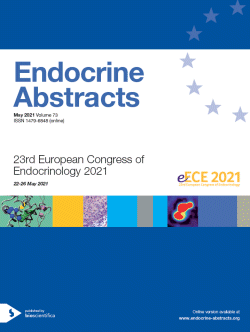
European Congress of Endocrinology 2021
Online
22 May 2021 - 26 May 2021
Oral Communications
Oral Communications 7: Diabetes, Obesity, Metabolism and Nutrition
ea0073oc7.1 | Oral Communications 7: Diabetes, Obesity, Metabolism and Nutrition | ECE2021
Circulating concentrations of TMAO is associated with all-cause mortality in subjects with Non-alcoholic fatty liver disease. Results from a dutch prospective cohort
Flores-Guerrero Jose L. , van Dijk Peter R. , Connelly Margery A. , Garcia Erwin , Navis Gerjan , Bakker Stephan J.L. , Dullaart Robin P.F.
ea0073oc7.2 | Oral Communications 7: Diabetes, Obesity, Metabolism and Nutrition | ECE2021
Hepatocyte GH signaling regulates carbohydrate processing in a STAT5b-independent manner
Vázquez-Borrego Mari C. , Del Rio-Moreno Mercedes , Sarmento-Cabral André , Mariyah Mahmood , Cordoba-Chacon Jose , Puchowicz Rhonda , Kineman Rhonda
ea0073oc7.3 | Oral Communications 7: Diabetes, Obesity, Metabolism and Nutrition | ECE2021
Long-term glucocorticoids are associated with increased odds of metabolic syndrome after an intensive combined lifestyle intervention
Mohseni Mostafa , Van der Valk Eline S. , Lengton Robin , Savas Mesut , Rijke Yolanda De , Van den Berg Sjoerd A.A. , Van der Voorn Bibian , Van Rossum Liesbeth F.C
ea0073oc7.4 | Oral Communications 7: Diabetes, Obesity, Metabolism and Nutrition | ECE2021
Liver GPR55 regulates NAFLD progression from steatosis to fibrosis
Fernández Uxía , Fernández Fondevila Marcos , González Rellán María Jesús , Da Silva Lima Natalia , Buque Xabier , González Rodríguez Marta , Delgado Teresa , Varela Rey Marta V , Eva Novoa , Tojo Marta , Marta Miguel , Diéguez Carlos , Diéguez Miguel , DiéguezMaría Luísa , Arrese Marco , García-Monzón Carmelo , Mato Jose , Aspichueta Jose , Nogueiras Rubén
ea0073oc7.5 | Oral Communications 7: Diabetes, Obesity, Metabolism and Nutrition | ECE2021
Hepatic O-GlcNAcylated-p53 as a hub integrating the glucose counterregulatory response and insulin-suppressed gluconeogenesis
González Rellán María Jesús , Fernández Fondevila Marcos , Fernández Paz Uxia , Rodríguez Amaia , Varela Rey Marta , Veyrat-Durebex Christelle , Seoane Samuel , Bernardo Ganeko , Fernando Lopitz Otsoa , Fernandez Ramos David F , Bilbao Jon , Iglesias Cristina , Müller David F , Herzig Stephan , Martinez Chantar Maria Luz , Perez Fernandez Roman , Lopez Miguel , Diéguez Roman , Maria Mato Jose , Millet Oscar , Coppari Roberto , Woodhoo Ashwin , Fruhbeck Gema , Nogueiras Pozo Rubén
ea0073oc7.6 | Oral Communications 7: Diabetes, Obesity, Metabolism and Nutrition | ECE2021
NTCP is a new promising target for treatment of metabolic diseases: A proof of mechanism from double-blind phase I clinical trials of Hepalatide
Zhu Zhenzhen , Tang Xiaolu , Zhu Shanwei , Wang Lizhen , Gao Xian , Cai Fei , Zhang Li , Liu Hongli , Wei Zhenman



